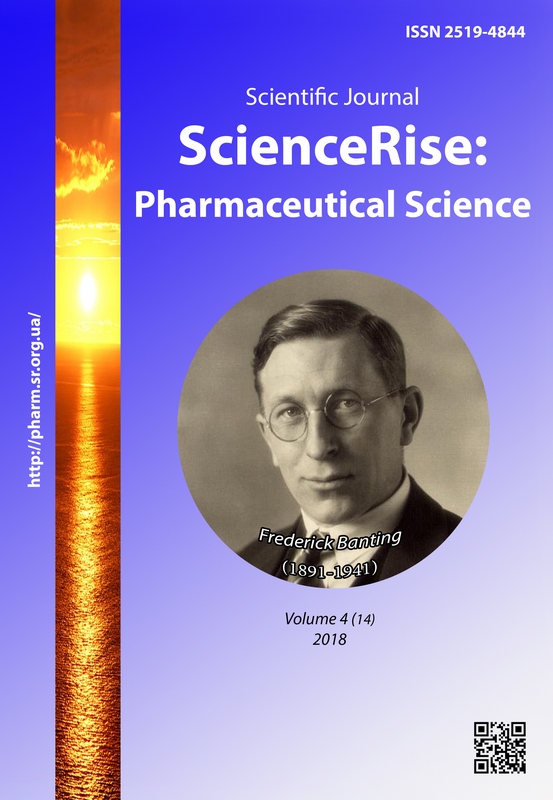Bio-based succinic acid sample preparation and derivatization procedure optimisation for gas chromatography-mass spectrometry analysis
DOI:
https://doi.org/10.15587/2519-4852.2018.135132Keywords:
succinic acid, gass chromatograpy-mass spectrometry, derivatization, BSTFA, metabolomics, GC-MSAbstract
This study focused on bio-based succinic acid sample preparation and derivatization conditions optimization using GC-MS analytical method. Succinic acid, the precursor of a wide range bio-compounds, especially it is important in accumulation of mitochondrial metabolite succinate (citric acid cycle) and during ischemia controls reperfusion injury through mitochondrial reactive oxygen production. Accurate determination of analytes is the key in metabolomics to use as low molecular biomarkers in case to improve diagnostic methods.
Methods. Gas chromatography-mass spectrometry (GC-MS) method. For the quantitative determination of the succinic acid applied derivatization process by silylation using -bis- (trimethylsilyl) -trifluoroacetamide (BSTFA).
Results. The derivatization agent BSTFA, the derivatization time of 3-4 hours and derivatization temperature at 70 °C were selected as the optimal derivatization condition for quantification of succinic acid by GС/MS in biological samples. The results show that GC-MS SIM method with evaporation was the most effective to quantify succinate in biological samples after ischemia/reperfusion injury. Selected ion monitoring (SIM) allowed to monitor a subset of fragments with their related mass values in a certain retention time (RT) range for a set of targets.
Conclusions. DC – MS has several advantages for measurements of succinate concentration in small kidney tissue samples (lyophilized mitochondria). The method can be applied in small pieces of tissue - biopy samples, tissues from various organs
References
- Orata, F. (2012). Derivatization Reactions and Reagents for Gas Chromatography Analysis. Advanced Gas Chromatography – Progress in Agricultural, Biomedical and Industrial Applications. InTech. doi: http://doi.org/10.5772/33098
- Lynch, T. P., Grosser, A. P. K. (2000). Inlet Derivatisation for the GC Analysis of Organic Acid Mixtures. Chromatography and Separation Technology, 13, 12–15.
- Schummer, C., Delhomme, O., Appenzeller, B., Wennig, R., Millet, M. (2009). Comparison of MTBSTFA and BSTFA in derivatization reactions of polar compounds prior to GC/MS analysis. Talanta, 77 (4), 1473–1482. doi: http://doi.org/10.1016/j.talanta.2008.09.043
- Dunn, W. B., Hankemeier, T. (2013). Mass spectrometry and metabolomics: past, present and future. Metabolomics, 9 (1), 1–3. doi: http://doi.org/10.1007/s11306-013-0507-z
- Jiye, A., Trygg, J., Gullberg, J., Johansson, A. I., Jonsson, P., Antti, H. et. al. (2005). Extraction and GC/MS Analysis of the Human Blood Plasma Metabolome. Analytical Chemistry, 77 (24), 8086–8094. doi: http://doi.org/10.1021/ac051211v
- Yip, L. Y., Yong Chan, E. C. (2013). Gas Chromatography/Mass Spectrometry-Based Metabonomics. Proteomic and Metabolomic Approaches to Biomarker Discovery. Elsevier, 131–144. doi: http://doi.org/10.1016/b978-0-12-394446-7.00008-x
- Fico, D., Margapoti, E., Pennetta, A., De Benedetto, G. E. (2018). An Enhanced GC/MS Procedure for the Identification of Proteins in Paint Microsamples. Journal of Analytical Methods in Chemistry, 2018, 1–8. doi: http://doi.org/10.1155/2018/6032084
- Peng, J., Tang, F., Zhou, R., Xie, X., Li, S., Xie, F. et. al. (2016). New techniques of on-line biological sample processing and their application in the field of biopharmaceutical analysis. Acta Pharmaceutica Sinica B, 6 (6), 540–551. doi: http://doi.org/10.1016/j.apsb.2016.05.016
- Ding, W.-H., Chiang, C.-C. (2002). Derivatization procedures for the detection of estrogenic chemicals by gas chromatography/mass spectrometry. Rapid Communications in Mass Spectrometry, 17 (1), 56–63. doi: http://doi.org/10.1002/rcm.819
- Villas-Bôas, S. G., Smart, K. F., Sivakumaran, S., Lane, G. A. (2011). Alkylation or Silylation for Analysis of Amino and Non-Amino Organic Acids by GC-MS? Metabolites, 1 (1), 3–20. doi: http://doi.org/10.3390/metabo01010003
- Chouchani, E. T., Pell, V. R., Gaude, E., Aksentijevic, D., Sundier, S. Y., Robb, E. L. et. al. (2014). Ischaemic accumulation of succinate controls reperfusion injury through mitochondrial ROS. Nature, 515 (7527), 431–435. doi: http://doi.org/10.1038/nature13909
- Ozpinar, A., Weiner, G. M., Ducruet, A. F. (2015). Succinate: A Promising Therapeutic Target for Reperfusion Injury. Neurosurgery, 77 (6), 13–14. doi: http://doi.org/10.1227/01.neu.0000473807.30361.29
- Rousova, J., Ondrusova, K., Karlova, P., Kubatova, A. (2014). Determination of Impurities in Bioproduced Succinic Acid. Journal of Chromatography & Separation Techniques, 6 (2). doi: http://doi.org/10.4172/2157-7064.1000264
- Tretter, L., Patocs, A., Chinopoulos, C. (2016). Succinate, an intermediate in metabolism, signal transduction, ROS, hypoxia, and tumorigenesis. Biochimica et Biophysica Acta (BBA) – Bioenergetics, 1857 (8), 1086–1101. doi: http://doi.org/10.1016/j.bbabio.2016.03.012
Downloads
Published
How to Cite
Issue
Section
License
Copyright (c) 2018 Laurynas Jarukas

This work is licensed under a Creative Commons Attribution 4.0 International License.
Our journal abides by the Creative Commons CC BY copyright rights and permissions for open access journals.








